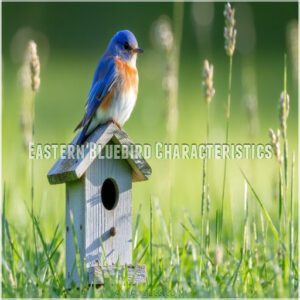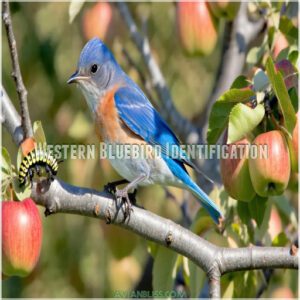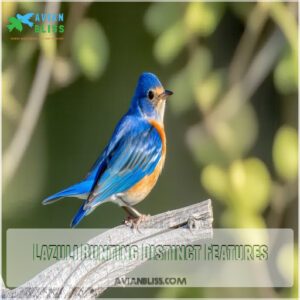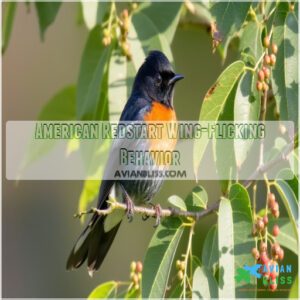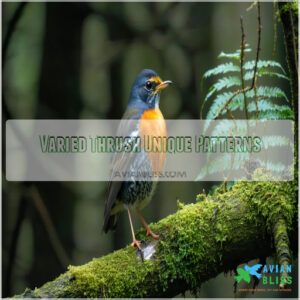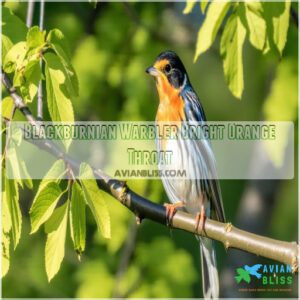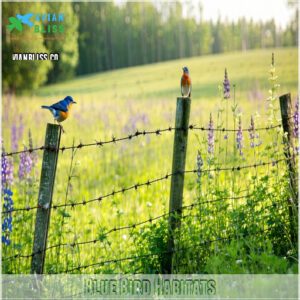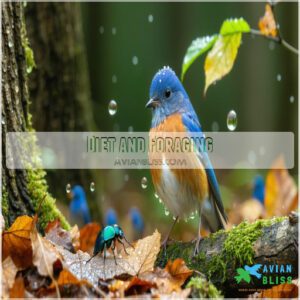This site is supported by our readers. We may earn a commission, at no cost to you, if you purchase through links.
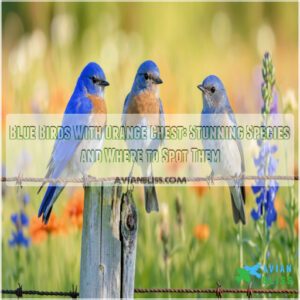 If you’re spotting blue birds with orange chests, you’re likely looking at species like the Eastern Bluebird, Western Bluebird, or Lazuli Bunting.
If you’re spotting blue birds with orange chests, you’re likely looking at species like the Eastern Bluebird, Western Bluebird, or Lazuli Bunting.
Eastern Bluebirds show off bright blue backs, orange chests, and white bellies, while Western Bluebirds add a rusty-orange flair.
Lazuli Buntings, on the other hand, combine brilliant blue plumage with soft orange-cinnamon chests and a neat touch of white.
These birds thrive in open areas like meadows, golf courses, or woodlands and feed on insects and berries.
Keep an eye out—they might even visit a nest box in your backyard!
Curious about their habitats or diets? Let’s explore!
Table Of Contents
- Key Takeaways
- Blue Birds Overview
- Birds With Orange Chest
- Blue Bird Habitats
- Diet and Foraging
- Conservation Status
- Frequently Asked Questions (FAQs)
- What does a blue bird with an orange chest mean?
- Which Bluebird has a red or orange chest?
- What birds have an orange chest?
- What birds have blue and orange plumage?
- How many blue birds have orange on their chest or belly?
- What are some examples of blue and orange birds?
- What is the name of the blue bird with orange chest?
- Are Eastern Bluebirds rare to see?
- What does it mean when you see an eastern bluebird?
- What states do Western Bluebirds live in?
- Conclusion
Key Takeaways
- You’ll often spot blue birds with orange chests like Eastern and Western Bluebirds or Lazuli Buntings in open areas like meadows, golf courses, or woodlands.
- These birds thrive on a diet of insects, wild fruits, and berries, making them nature’s pest controllers and seed spreaders.
- Eastern Bluebirds and other species have benefited from conservation efforts like nest boxes, which help combat habitat loss and competition.
- Their vibrant blue and orange colors make them easy to identify, with males showing brighter hues to attract mates while females feature subtler tones.
Blue Birds Overview
Blue birds with orange chests are some of the most striking species you’ll notice in the wild, blending vibrant colors with unique patterns.
From Eastern Bluebirds to Lazuli Buntings, these feathered gems offer plenty to spot and admire.
Eastern Bluebird Characteristics
Spotting an Eastern bluebird is like finding a gem.
These blue birds with an orange chest are small but dazzling!
Males flaunt bright blue wings and rusty orange feathers, while females are subtler.
They’ve got fascinating mating and nesting habits, often raising several broods a year.
They readily accept artificial nest boxes, which have become essential for their survival.
- Key traits: blue back, orange chest, white belly.
- Enjoy meadows and golf courses!
- Love insects and berries.
Western Bluebird Identification
The Western Bluebird stands out among blue birds with its brilliant blue plumage and warm orange chest.
Males are vibrant, while females keep it subtle with grayish tones.
These social bluebirds often form flocks, sharing their melodic Western songs.
Similar species, like the Eastern Bluebird, enjoy a diet of insects and fruits.
For quick identification, check this handy table:
| Trait | Males | Females |
|---|---|---|
| Plumage | Shiny blue | Gray-buff with blue tints |
| Chest Color | Rusty orange | Pale orange |
| Size | Small, stocky thrush | Small, stocky thrush |
Lazuli Bunting Distinct Features
The Lazuli Bunting is a stunning blue bird with an orange chest that’s hard to miss.
Its brilliant blue plumage, soft orange-cinnamon chest, and crisp white details make it a favorite.
This blue and orange chested bird sings from shrubs and brushy hillsides, often during its seasonal bird migration.
Its neat feather patterns and cone-shaped beak are tiny works of art.
Birds With Orange Chest
When you spot a bird with a bright orange chest, it’s hard not to stop and admire its striking colors.
These birds, like the energetic American Redstart or the bold Varied Thrush, bring a splash of brilliance to forests and fields.
American Redstart Wing-Flicking Behavior
The American Redstart is a fascinating blue and orange chested bird with a unique wing-flicking flair.
Watch them dart through branches with flashy feather displays that scare up tasty insects.
You’ll spot:
- Bold black and orange males showing off during courtship displays.
- Lively bird migration paths through North America.
- Flight patterns chasing bugs mid-air.
- Adorable females in subtle gray-yellow hues.
Varied Thrush Unique Patterns
If you thought American Redstarts had striking looks, the Varied Thrush brings its A-game.
This blue bird with an orange chest flaunts vibrant feather colors and bold bird markings.
Males show rich orange and gray plumage textures, accented by sharp beak shapes.
They favor dense forests and sing haunting, flute-like songs.
A true standout among orange breasted birds!
Blackburnian Warbler Bright Orange Throat
If you’ve spotted a blue bird with an orange chest glowing like firelight, it’s likely the Blackburnian Warbler.
Their bright orange plumage and black throat patches stand out in treetops.
Many other birds also sport orange chests, as detailed in this online bird guide.
These orange-breasted birds migrate across the Gulf, filling forests with sweet bird songs. Look during Warbler migration to catch their fiery feather coloration lighting up the trees.
Blue Bird Habitats
You’ll often find blue birds with orange chests in open spaces like fields, meadows, and even golf courses.
These birds also call areas across Eastern North America and as far south as Nicaragua their home, sticking to places with patchy vegetation and plenty of room to perch.
Open Country With Patchy Vegetation
You’ll often spot a blue bird with an orange chest in open country with patchy vegetation, like rural landscapes and wildflower plains.
These areas offer plenty of insects and berries, a perfect setup for Eastern and Western bluebirds.
Creating a backyard habitat can also attract these beautiful birds.
Keep an eye on grassland birds in open woodlands or patchy meadows—they love these habitats for nesting and foraging!
You can learn more about ideal eastern bluebird habitats.
Meadows, Old Fields, and Golf Courses
Meadows, old fields, and golf courses are hotspots for spotting Eastern bluebirds.
These wide-open spaces with short grasses and scattered trees create perfect Meadow Ecosystems for nesting and hunting insects.
For birders, specialized golf course bird watching equipment can enhance the experience.
Bird watching locations like golf courses offer natural perks—watch for the flash of a blue bird with an orange chest perched on a fence or snag.
It’s wildlife in plain sight!
Eastern North America and Nicaragua
Love bird watching? You’ll find the Eastern bluebird thriving across Eastern North America and parts of Nicaragua, flaunting its blue feathers and orange chest.
These areas are perfect for spotting them in:
- Bird sanctuaries rich with wildlife diversity.
- Tropical forests, home to many migratory patterns.
- Avian research sites, essential for understanding blue birds.
Pack binoculars – adventure awaits!
Diet and Foraging
You’ll find that blue birds with orange chests are always on the hunt for insects, wild fruits, and berries to fuel their energy.
They often forage by perching low, scanning the ground, and snapping up their next meal with precision.
Insect-Based Diet
Blue birds like the Eastern bluebird with its orange chest are naturals at insect catching.
Whether they’re fly snatching mid-air or spider hunting along branches, their diets focus on protein-packed bugs.
Providing insect-based bird food can supplement their natural foraging.
They’ll gulp beetles, moths, and caterpillars, all while showcasing acrobatics that’ll wow you.
Watching them in action is like front-row seats to nature’s own pest control!
Wild Fruit and Berries Consumption
Blue birds with orange chests love a fruity feast.
They’ll snack on berries like elderberries or dogwood fruit, perfect for energy-packed nutrient intake.
Their fruit preferences help with seed dispersal, spreading plants as they forage.
Watching their foraging habits, you’ll notice how quick they’re at spotting bright berries.
It’s nature’s clever way of teamwork between birds and plants, showcasing a fruity feast as a key component of their interaction.
Ground Foraging and Perching Behavior
Watching a blue bird with an orange chest forage is like seeing a little detective at work.
Their feeding strategies are fascinating:
- Ground Searching: Hop or walk lightly, scanning for insects or seeds.
- Perch Selection: Pick low branches to swoop down quickly.
- Bird Posture: Alert stance, head tilted while scouting.
- Foraging Techniques: Quick dives or pecks for hidden snacks!
Conservation Status
You might be surprised to learn that many blue birds with orange chests, like the Eastern and Western Bluebirds, are doing well but still face challenges.
Loss of habitat, competition for nesting spots, and changing environments mean conservation efforts are key to keeping their populations steady.
Eastern Bluebird Population Trends
Eastern bluebird numbers are bouncing back, thanks to bird conservation efforts like nest box programs and controlling invasive species.
Once hit hard by habitat fragmentation and harsh winters, these blue birds with orange chests now thrive in open spaces.
To learn more about their habits, explore this Eastern Bluebird overview.
While climate impact and migration patterns remain challenges, their population growth shows promise with nesting success improving steadily.
Western Bluebird Habitat Loss
Western bluebirds face habitat fragmentation from urban expansion, logging, and a lack of dead trees for nesting.
Non-native birds, like starlings, outcompete them. Plus, climate change messes with food availability.
Here’s how human impact affects them:
- Logging eliminates key nesting spots.
- Grazing disrupts ecosystems.
- Fewer shrubs = less food.
- Dense forests block their habitats.
- Cold, wet weather reduces prey.
Conservation Efforts and Initiatives
Protecting blue birds isn’t rocket science, but it does take effort.
Simple steps like putting up nest boxes or supporting bird conservation efforts can make a big difference for species like the Eastern bluebird.
You can further contribute to Eastern bluebird conservation efforts by purchasing related products.
Community action and habitat preservation are key to wildlife conservation.
| Action | Impact |
|---|---|
| Nest Boxes | Boosts nesting and population growth |
| Habitat Preservation | Protects ecosystems for biodiversity |
| Supporting NGOs | Funds research and species protection |
| Spreading Awareness | Educates others about bird conservation |
| Planting Native Trees | Restores ecosystems and attracts birds |
Frequently Asked Questions (FAQs)
What does a blue bird with an orange chest mean?
You might be spotting a bluebird, like the Eastern Bluebird or Western Bluebird.
Their stunning blue feathers and orange chest symbolize joy and renewal, often linked to happiness, freedom, and nature’s colorful beauty.
Which Bluebird has a red or orange chest?
A bluebird with a bluebird or orange chest usually refers to the males of the Eastern or Western Bluebird species.
Their vibrant coloring helps them attract mates, while females have softer, muted tones.
What birds have an orange chest?
Birds with orange chests include the American Robin, Eastern Bluebird, Western Bluebird, and Barn Swallow.
Their colorful chests often help with identification, so spotting one can feel like nature’s version of a treasure hunt!
What birds have blue and orange plumage?
You’ve got birds like the Eastern Bluebird, Western Bluebird, and Lazuli Bunting flaunting blue backs and orange chests.
Their vibrant plumage turns heads, especially in open fields or woodlands where they hang out.
How many blue birds have orange on their chest or belly?
Around six birds show off blue plumage and an orange chest or belly, like the Eastern and Western Bluebirds, Lazuli Bunting, and Barn Swallow.
It’s like nature designed them with perfect color coordination!
What are some examples of blue and orange birds?
You’ve got some stunners like the Eastern Bluebird, with its bright orange chest, or the Lazuli Bunting, rocking cinnamon hues.
The Western Bluebird also rocks those bold colors in open woodlands and fields.
What is the name of the blue bird with orange chest?
One standout bird with a blue body and orange chest is the Eastern Bluebird.
It’s a small, vibrant songbird with a bright royal blue back and rusty-orange chest that catches everyone’s eye.
Are Eastern Bluebirds rare to see?
Ever wondered if Eastern Bluebirds are hard to spot.
They’re not exactly rare, but it depends on where you live.
They thrive in open spaces and fields—set up a birdhouse, and they might visit!
What does it mean when you see an eastern bluebird?
Seeing an Eastern Bluebird often symbolizes joy, hope, and renewal.
It’s like nature’s happy little reminder to embrace positivity and cherish simple moments.
Plus, their vibrant colors just brighten your day instantly!
What states do Western Bluebirds live in?
Western Bluebirds hang out in places like California, Arizona, Oregon, and as far up as Washington.
You’ll also spot them in Rocky Mountain states like Colorado.
They love open woods, deserts, and forest edges!
Conclusion
Imagine spotting a splash of blue and orange darting through the trees—it’s like nature’s watercolor painting in motion.
Blue birds with orange chests bring vibrant beauty to your backyard or park visits.
Whether it’s the Eastern Bluebird, Western Bluebird, or Lazuli Bunting, these species thrive in open spaces and enjoy a mix of insects and berries.
Keep an eye out, especially in meadows or fields, and maybe offer a nest box to invite these colorful friends closer!
- https://www.allaboutbirds.org/guide/Eastern_Bluebird/id
- https://birdserenity.com/blue-birds-with-orange-chests/
- https://www.sleepingbearwildlife.org/easternbluebird
- https://dnr.illinois.gov/education/wildaboutpages/wildaboutbirds/wildaboutbirdsthrushes/wabeasternbluebird.html
- https://www.lyricbirdfood.com/birding-hub/birds/eastern-bluebird/

